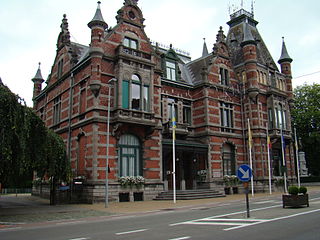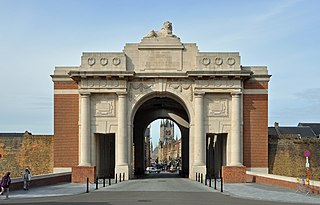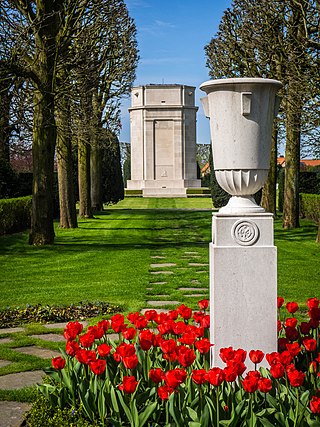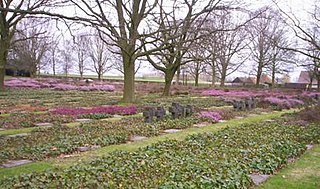
Menen is a city and municipality located in the Belgian province of West Flanders. The municipality comprises the city of Menen proper and the towns of Lauwe and Rekkem. The city is situated on the French/Belgian border. On January 1, 2006, Menen had a total population of 32,413. The total area is 33.07 km² which gives a population density of 980 inhabitants per km².

Wevelgem is a municipality located in the Belgian province of West Flanders. The municipality comprises the towns of Gullegem, Moorsele and Wevelgem proper. On January 1, 2006, Wevelgem had a total population of 31,020. The total area is 38.76 km² which gives a population density of 800 inhabitants per km².

Ypres is a Belgian city and municipality in the province of West Flanders. Though the Dutch name Ieper is the official one, the city's French name Ypres is most commonly used in English. The municipality comprises the city of Ypres/Ieper and the villages of Boezinge, Brielen, Dikkebus, Elverdinge, Hollebeke, Sint-Jan, Vlamertinge, Voormezele, Zillebeke, and Zuidschote. Together, they are home to about 34,900 inhabitants.

The Menin Gate, officially the Menin Gate Memorial to the Missing, is a war memorial in Ypres, Belgium, dedicated to the British and Commonwealth soldiers who were killed in the Ypres Salient of World War I and whose graves are unknown. The memorial is located at the eastern exit of the town and marks the starting point for one of the main roads that led Allied soldiers to the front line.

Vladslo German war cemetery is about three kilometres north east of Vladslo, near Diksmuide, Belgium. Established during World War I, the cemetery holds 3,233 wartime burials. In 1956, burials from many smaller surrounding cemeteries were concentrated in Vladslo, and it now contains the remains of 25,644 soldiers. Each stone bears the name of twenty soldiers, with just their name, rank, and date of death specified.

Flanders Field American Cemetery and Memorial is a World War I cemetery in the city of Waregem, Belgium. Originally a temporary battlefield burial ground, Flanders Field American Cemetery later became the only permanent American World War I cemetery in Belgium. The Flanders Field American Cemetery commemorates 411 service members of the United States Armed Forces of which 368 are interred. The Walls of the Missing inside the chapel venerates 43 missing service members.

Wimereux is a commune in the Pas-de-Calais department in the Hauts-de-France region of France.

RE Grave, Railway Wood is a Commonwealth War Graves Commission (CWGC) memorial and war grave located in the Ypres Salient on the Western Front. It is located on the Bellewaerde Ridge near Zillebeke, about 4 kilometres east of Ypres, and a little north of Hooge. The area of the Cambridge Road sector, halfway in between Wieltje and Hooge, was the site of intensive underground fighting in the First World War. The Liverpool Scottish Memorial, Railway Wood is located nearby.

Henri-Chapelle American Cemetery and Memorial is a Second World War American military war grave cemetery in eastern Belgium. It is 3 km (2 mi) northwest of Henri-Chapelle, about 30 km (20 mi) east of Liège. Dedicated in 1960, the cemetery contains 7,992 American war dead and covers 57 acres (23 ha).

Hooge Crater Cemetery is a Commonwealth War Graves Commission burial ground for the dead of the First World War located in the Ypres Salient in Belgium on the Western Front. Hooge Crater Cemetery is named after a mine crater blown nearby in 1915 and located near the centre of Hooge, opposite the "Hooge Crater Museum" and separated from it by the Menin Road. Hooge itself is a small village on the Bellewaerde Ridge, about 4 kilometres east of Ypres in the Flemish province of West Flanders.

The Kopli cemetery was Estonia's largest Lutheran Baltic German cemetery, located in the suburb of Kopli in Tallinn. It contained thousands of graves of prominent citizens of Tallinn and stood from 1774 to shortly after World War II, when it was completely flattened and destroyed by the Soviet occupation authorities governing the country at the time. The former cemetery is now a public park.

Haydarpaşa Cemetery, also known as Haidar Pasha Cemetery, Istanbul,, located in the Haydarpaşa neighborhood of Üsküdar district in the Asian part of Istanbul, Turkey, is a burial ground established initially for British military personnel who took part in the Crimean War (1854–1856). The cemetery holds also graves of Commonwealth soldiers from the two World Wars, and civilians of British nationality.
The German War Graves Commission is responsible for the maintenance and upkeep of German war graves in Europe and North Africa. Its objectives are acquisition, maintenance and care of German war graves; tending to next of kin; youth and educational work; and preservation of the memory to the sacrifices of war and despotism. Former head of the Bundeswehr Wolfgang Schneiderhan was elected President of the organisation in 2016, succeeding SPD politician Markus Meckel. The President of Germany, currently Frank-Walter Steinmeier (SPD), is the organisation's patron.

The Cannock Chase German Military Cemetery is on Cannock Chase, Staffordshire, England. The cemetery contains nearly 5,000 burials from both the First and Second World War. The burials are mainly German and Austrian nationals with a very small number of Ukrainians.

The Hooglede German war cemetery is a military cemetery in the Belgian town of Hooglede, six kilometer northwest of Roeselare. It is located at the east side of Hooglede. It contains 8,241 buried German soldiers from World War I.

Brookwood American Cemetery and Memorial is the only American Military Cemetery of World War I in the British Isles. Located approximately 28 miles (45 km) southwest of London, Brookwood American Cemetery contains the graves of 468 American war dead, including the graves of 41 unknown servicemen, from World War I.

The Alter Nordfriedhof is a former cemetery located in the Arcisstrasse in Maxvorstadt, Munich, Bavaria, Germany. It is not to be confused with the Nordfriedhof in Munich, which was set up only a short time later in Schwabing. Construction began in 1866 to designs by the city architect Arnold Zenetti.

Hamburg Commonwealth War Graves Commission Cemetery is a war cemetery which was built and is looked after by the Commonwealth War Graves Commission (CWGC). The war graves of 676 Commonwealth service personnel from World War I and 1,889 from World War II are located near Chapel 12 in the greater Ohlsdorf Cemetery in the Ohlsdorf quarter of Hamburg.

Hollybrook Cemetery is a cemetery in Bassett, Southampton, England containing around 53,000 graves as of August 2012 and still open to new burials as of March 2016. It is one of the main cemeteries in Southampton.























